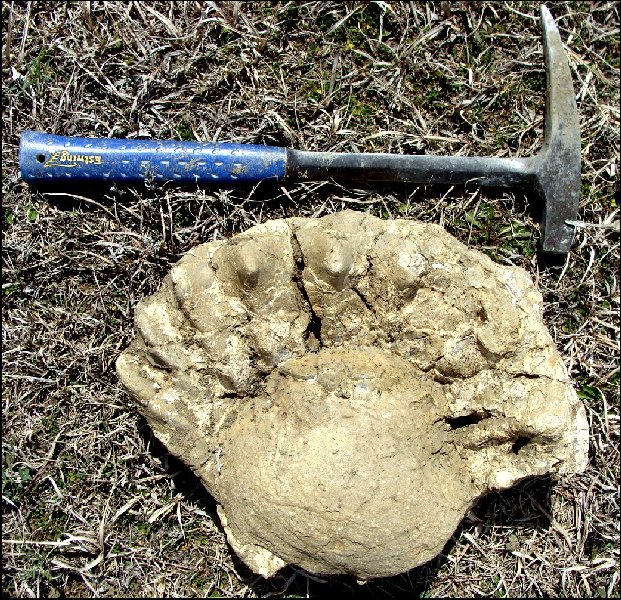 |
Kansas Ammonites
(Cephalopoda: Ammonoidea)
Page created 04/18/2010; Last updated 08/04/2010
Copyright © 2010 by Mike Everhart
Definitely a work in progress.....
LEFT: An internal mold of a portion
of the the outer coil of a large ammonite (Prionotropis hyatti) from the upper
Blue Hill Shale of northeast Russell County, Kansas. Rock hammer is 41 cm (16 in) in
length. Collected by Bruce Schumacher, April, 2010. |
The preserved shells and internal casts of ammonites are common occurrences in
Mesozoic marine sediments around the world and are often used by paleontologists as
stratigraphic markers. However, they are only rarely preserved in the Smoky Hill
Chalk Member of the Niobrara Chalk, and I have thus pretty much avoided saying much about
them. Recently, however, I've had opportunities to collect fossils in other Cretaceous
formations in north-central Kansas and have been able to collect several species of
ammonites. In addition, I co-authored a paper with Anthony Maltese about the first
discovery of a heteromorph ammonite in the Smoky Hill Chalk (see photos below):
| Everhart, M.J. and
Maltese, A. 2010. First report of a heteromorph ammonite, cf. Glyptoxoceras,
from the Smoky Hill Chalk (Santonian) of western Kansas, and a brief review of Niobrara
cephalopods. Kansas Academy of Science, Transactions 113:(1-2):64-70. In
June, 2008, the partial internal mold of a small ammonite was discovered beneath a Tylosaurus
nepaeolicus skull collected from the Clioscaphites vermiformis-C. choteauensis zone
(early to mid-Santonian), Smoky Hill Chalk. in northern Lane County, Kansas by staff of
the Rocky Mountain Dinosaur Resource Center. The specimen was collected and later donated
to the Sternberg Museum of Natural History. The ammonite did not appear to be directly
associated with the vertebrate remains. The mold preserves a trace of the siphuncle as
distinct line visible for about 4 cm along near the outer edge of the specimen. Although
incomplete, the specimen preserves the distinctive uncoiled form of a heteromorph
ammonite, and appears to be quite similar to a species (Glyptoxoceras texanum)
recently named from Santonian deposits in northeastern Texas. This specimen is the first
known occurrence of a heteromorph ammonite in the Smoky Hill Chalk. |
A brief background of Kansas ammonites from the Introduction of Everhart and
Maltese, 2010:
"Cephalopods, including ammonites, occur in relative abundance in
several Late Cretaceous formations in Kansas, but are seldom observed or collected from
the Smoky Hill Chalk Member of the Niobrara Chalk due to the poor preservation of their
aragonitic shells (Hattin, 1982). Among the first to mention Niobrara ammonites was
Williston (1897, p. 242) who wrote that they “occur, though rarely, and almost always
only impressions are found, with but little of the shell substance. Once or twice I have
seen such impressions a foot in diameter.”
Logan (1898) does not mention the ammonite impressions noted by
Williston, but does report on discovery of a new species of another cephalopod, a squid
which he named Tusoteuthis “longus” (corrected for gender to T.
longa by Miller, 1968). Several other
species of squid were named by Miller (1968, 1969) and Green (1977), but these have since
been synonymized with T. longa (Nicholls and Izaak 1987; Stewart and Carpenter
1990).
In his paper on the Kansas Niobrara, Williston (1897) also noted that
baculites had never been collected from the chalk, but indicated that Baculites ovatus
had been found in the overlying Pierre Shale near McAllister Butte in western Logan County.
Morrow (1935, pl. 53, fig. 7) was the first to describe and figure the internal mold of a
baculite (Baculites sp. cf. B. ovatus) from chalk of Trego County. Since
that time the molds of baculites have been recognized by several authors (Miller 1968,
1969; Hattin 1982; Hasenmueller and Hattin, 1985; Stewart 1990).
Based on a single, damaged specimen in the University of Kansas
collection, Jeletzky (1955) reported on the first belemnite from the Smoky Hill Chalk
which he identified as Belemnitella praecursor. Two years later, Miller (1957) also
described Belemnitella praecursor from 12 specimens collected by G.F. Sternberg and
M.V. Walker. Those specimens apparently had not been available to Jeletzky. Following
Miller’s publication, Jeletzky (1961) was able to examine the material in the
collection of the Sternberg Museum, and subsequently redescribed them as belonging to the
genus Actinocamax, including two new species, A. sternbergi and A.
walkeri. Hattin (1982) mentions that belemnites are rare in the chalk, but did not
figure them.
In his paper describing cephalopods from the Cretaceous of Kansas,
Morrow (1935, pl. 53, fig. 1-2) briefly describes a large, unnumbered specimen (Ammonite
sp., “close to Pachydiscus”) from the Smoky Hill Chalk in Logan County in
the collection of the University of Kansas, and a nautiloid (Eutrephoceras) from
the underlying Fort Hays Limestone of Phillips County. Morrow (ibid., p. 466, pl. 50, fig.
4a-d) also described and named a heteromorph scaphite (Scaphites carlilensis) from
the Blue Hill Shale (Middle Turonian) in Mitchell County, Kansas. Miller (1968) assigned
the unnumbered KU specimen reported by Morrow to “Brevahites? sp.
A” and figured a similar specimen (FHSM IP-12029-2) in the Sternberg Museum
collection that he called “Brevahites? sp. B” (subsequently
referred to Submortoniceras sp. by Miller 1969). While most ammonite specimens have
been collected from Gove and Logan counties, Miller (1969, p. 535) reported
“abundant” ammonite remains from a fossiliferous locality in northwestern Rooks County,
including several fragmentary molds of large ammonites. Another heteromorph ammonite, Didymoceras
nebrascense Meek and Hayden 1856, has been collected from the overlying Pierre Shale
in western Kansas (Kennedy, et al., 2000).
Internal molds of Clioscaphites vermiformis Meek and Hayden
(1862) and C. choteauensis Cobban (1951) also occur in the middle Santonian Smoky
Hill Chalk, and are used as stratigraphic markers (Hattin, 1982; Stewart, 1990). In at
least one instance, several individuals have been collected in close proximity (MJE, pers.
obs., 2007), suggesting a mass die-off. Although these two species of Clioscaphites
occur in adjacent stratigraphic layers according to Kauffman, et al. (1993), Carpenter
(2003) noted that Stewart (1990) had combined them into a single biostratigraphic zone in
the Smoky Hill Chalk due to poor preservation. Hattin (1982, p. 70) suggests that
cephalopods are rare in most of the Smoky Hill Chalk because of less-than-normal salinity,
and that the occurrence of Clioscaphites may represent a time when salinity
returned to normal marine levels.
The calcitic aptychi of ammonites (Everhart, 2005, fig. 3.4) are preserved
occasionally at various stratigraphic levels in the chalk. Hattin (1982) noted that the
remains of cephalopods belonging to the Collignoniceratidae are rare and mostly only
represented by aptychi. Although there has been considerable debate over use of aptychi as
ammonite opercula or jaws (Morton, 1981), more recently it has been suggested by Lehmann
and Kulicki (2007) that they served as both operculum and cutting edges of the lower jaws.
In his description of the Niobrara vertebrate stratigraphy, Stewart (1990) designated two
of his biostratigraphic zones based on occurrence of “Spinaptychus n.
sp.” and “Spinaptychus sternbergi,” and noted occurrence of a third
form, “Rugaptychus sp.” in the Zone of Hesperornis (Early
Campanian). Another aptychi form (“Spinaptychus n. sp. B”; J.D. Stewart,
pers. comm. 1991) is present in the Zone of Protosphyraena perniciosa (Upper
Coniacian; Everhart, 2005). None of these aptychi, however, has been described in
association with identifiable ammonites although fragments of a pair of Spinaptychus
n. sp. aptychi were discovered in association with the internal cast of an ammonite
informally referred to as “Texanites” (J.D. Stewart, pers. comm. 1993;
Everhart, 2005)." |
That said, I know barely enough about these invertebrates to be dangerous. So
bear with me and I will show some of the specimens that I have collected or seen collected
from Kansas rocks in the last five years. We'll start with the youngest Cretaceous rocks
in Kansas (Pierre Shale Group) and go down in time to the oldest - the Kiowa Formation:
Other ammonite related sites:
The Geology of
Portsdown Hill Ammonite page
Sharon Springs Formation (Pierre Shale Group) - Middle Campanian:
Ammonites occur rarely in the shales that overlie the Niobrara Formation in
far-western Kansas. Baculites are more commonly collected there. I'll add
pictures at a later date:
Smoky Hill Chalk Member of the Niobrara Chalk Formation - Upper Coniacian
to Lower Campanian:
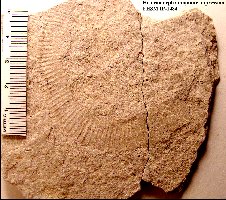 |
LEFT: The piece of chalk that preserves an impression (internal
mold) of a heteromorph ammonite (FHSM IP-1484). This is the first such specimen ever
collected from the Smoky Hill Chalk. The specimen was collected by Anthony Maltese in
northern Lane County. RIGHT: A close-up of IP-1484 showing the dark
trace that indicates the probable location of the siphuncle in the living ammonite. The
siphuncle is a living tube that passes from the body of the ammonite through each chamber
of the ammonite’s shell. It allows the extraction of water from and the injection of
gas into the otherwise closed off older chambers of the shell. This enables the ammonite
to adjust the amount of water in the hollow shell compartments and allows the animal to
control its buoyancy to a certain extent. In this preservation, the structure in the
circle may represent the terminus of the siphuncle where it enters the living chamber. See
another example below. |
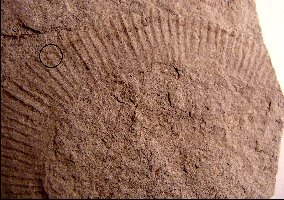 |
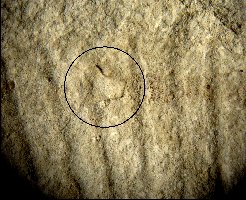 |
LEFT: The probable funnel shaped terminus of the siphuncle tube
in FHSM IP-1484
RIGHT: An internal mold of Clioscaphites choteauensis from the middle
of the Smoky Hill Chalk. According to Cobban, this is the only species of Scaphites
found in the chalk. (About 4 in / 10 cm in diameter) |
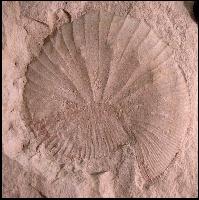 |
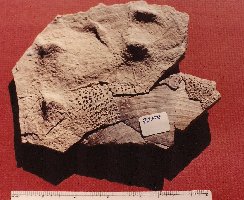 |
LEFT: A portion of the internal mold a "Texanites"
ammonite from the Smoky Hill Chalk collected by Duffer Mauck of Hoxie,
Kansas. Note that a portion of an associated aptychus is also preserved
laying the ammonite mold. Ammonite shells were composed aragonite and were generally
dissolved before they could be fossilized. The smaller and thinner aptychi, on the other
hand, were composed of calcite and preserve very well, sometimes with exquisite detail
(below).
RIGHT: Another fragment of the same specimen. Photos by
Mike Everhart, courtesy of J.D. Stewart. |
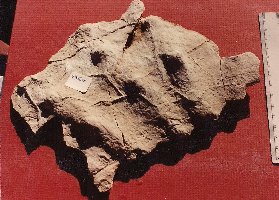 |
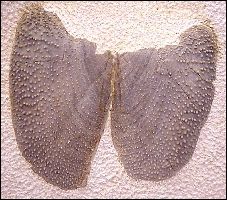 |
Spinaptychus is the term used to describe the paired
structures (aptychi) that probably served as jaw structures for the ammonite (similar to
squid beaks). They look like the inside of a clam shell (smooth) on the inside while the
outside is covered with numerous, short projections or spines. Several types of "Spinaptychi"
are found in the chalk. LEFT: Spinaptychus sp.:
An ammonite aptychi specimen (FHSM IP-528) on
exhibit in the Sternberg Museum. Note this publication is
available on the web: Fischer, A.G. and Fay, R.O. 1953. A spiny aptychus from
the Cretaceous of Kansas. Bulletin Geological Survey Kansas. 102(2):77-92, 2 pl.
RIGHT: A large ammonite aptychus - FHSM IP-941 |
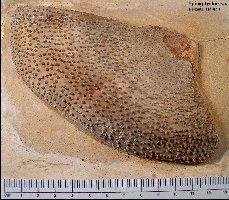 |
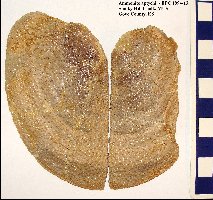 |
LEFT: A pair of aptychi (EPC 1994-13) that I
collected in 1994 from the lower chalk of Gove County (about 4 inches tall).
This specimen was prepared by Neal Larson (Black Hills Institute).
Close-up views of two other fragmentary specimens are HERE.
Note that these structures are rather thin and delicate, with thickness
that varies from 1 to 2 mm, except at the hinges where it is somewhat
thicker.
RIGHT: Another nice Spinaptychus sp. specimen (RMDRC 10-018)
collected in 2010 from the lower chalk of Gove County by Anthony Maltese
(Rocky Mountain Dinosaur Resource Center). This specimen was
prepared, including minor reconstruction, by Neal Larson (Black
Hills Institute). |
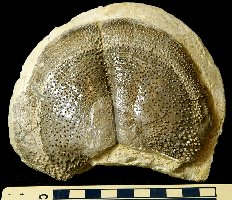 |
Blue Hill Shale Member of the Carlile Shale Formation - Upper Middle
Turonian:
The Blue Hill Shale ammonite fauna is pretty much dominated by the occurrence
of a large ammonite called Prionotropis hyatti (formally Collignoniceras
hyatti) - See picture at top of this page -
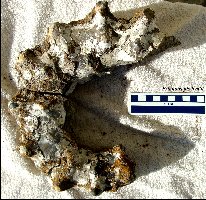 |
LEFT: The outer coil of a Prionotropis hyatti ammonite
collected by Gail Pearson in March, 2010, from the Blue Hill Shale in southwestern
Mitchell County, KS. RIGHT: Part of the inner coil of a similarly-sized
Prionotropis hyatti ammonite that I collected in March, 2010. Note the
distinctive suture formed between adjacent chambers of the ammonite. Another example is shown HERE.
Unfortunately the larger
outer coil was only partially preserved. However, this fragment preserves the terminus
of the siphuncle on the upper edge, just below the keel. Several smaller ammonites were preserved
in the concretion that formed around this ammonite. |
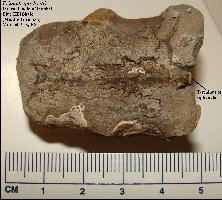 |
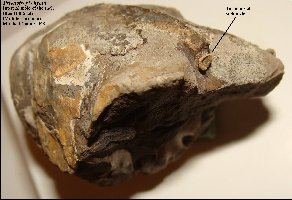 |
LEFT: Close-of the Prionotropis fragment showing the
terminus of the siphuncle. RIGHT: An anterior end view of one of the
chambers, showing the terminus of the siphuncle just below the keel of the shell. |
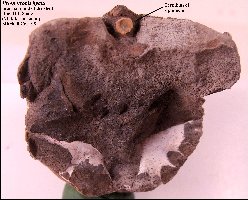 |
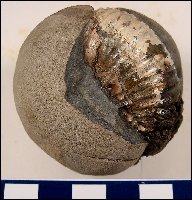 |
LEFT: The Blue Hill Shale also preserves smaller ammonites inside
"mud balls", small gray concretions about the size of a baseball.
Sometimes cracking them open with a hammer will reveal an ammonite or other shell
inside.... RIGHT: Another mud ball ammonite. |
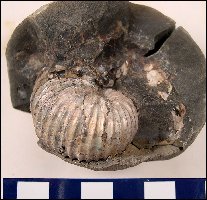 |
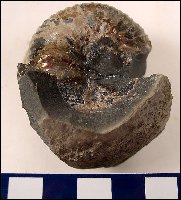 |
LEFT: Another ammonite preserved in a mud ball... these are
actually limestone concretions that formed around the ammonite on the muddy bottom of the
sea. RIGHT: A small Prionotropis hyatti ammonite preserved
partially inside a mud ball concretion. In this case, outer edge of the ammonite was
visible before the concretion was cracked open. |
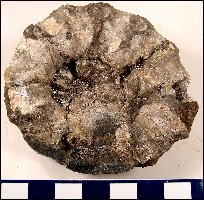 |
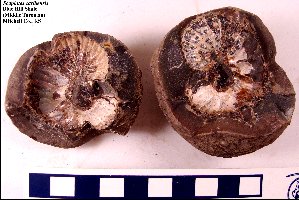 |
LEFT: A heterotroph ammonite and the counter-part that was broken
off to reveal it. In this case the ammonite is a species which was discovered first in
Kansas, called Scaphites carlilensis, for the Carlile Shale Formation. RIGHT:
Another Scaphites carlilensis that still preserves some of the rainbow of colors
in the nacre. |
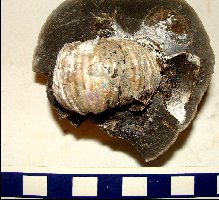 |
 |
LEFT: Still another Scaphites carlilensis with slightly
different preservation. If you look at the right side of the shell, you can see that some
of the sutures are preserved. RIGHT: Another Scaphites carlilensis,
but this one is preserved in the "red rock" layer that occurs about 3 m below
the layer containing the mud balls. In this case, most of the original shiny nacre of the
shell is preserved. |
 |
Greenhorn Formation - Lower Turonian to Middle Cenomanian:
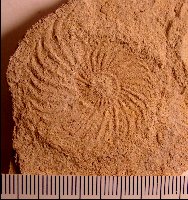 |
LEFT: The internal mold of a small, unidentified ammonite
discovered in the Pfeifer Shale, the upper most member of the Greenhorn Formation. This
specimen was collected about 1 m below the Fencepost Limestone during the dig on a
plesiosaur in eastern Russell County, KS. The preservation (or lack thereof) is similar to
ammonites in the Smoky Hill Chalk (above). RIGHT: A badly weathered
internal mold of an ammonite, probably Calyceras sp. from the Lincoln Limestone,
the lowermost member of the Greenhorn Formation (Middle Cenomanian). In this case,
it was discovered at the site of a large elasmosaur collected by George Sternberg and M.V.
Walker in 1930, near Holyrood, Kansas (Ellsworth County). |
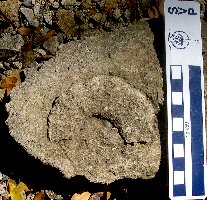 |
Kiowa Formation - Upper Albian (Early Cretaceous):
 |
LEFT: An Engonoceras sp. ammonite from the Kiowa Shale
of McPherson County, KS. Note the difference in the sutures compared to Prionotropis
(above).
RIGHT: .... and for something a little different, an unidentified
Pennsylvanian-age Ammonoid preserved in limestone from near Sedan, Kansas (Chautauqua
County) ..... about 300 million years old. |
 |
REFERENCES:
Carpenter, K. 2003. Vertebrate biostratigraphy of
the Smoky Hill Chalk (Niobrara Formation) and the Sharon Springs Member (Pierre Shale).
pp. 421-437 in Harries, P.J. (ed.), Approaches in High-Resolution Stratigraphic
Paleontology, Kluwer Academic Publishers, The Netherlands.
Cobban, W.A. 1951. Scaphitoid cephalopods of the
Niobrara Group. U.S. Geological Survey Professional Paper, 239, 42 pp.
Crampton, J.S. 2004. Shell composition, cryptic
costae, complex composite molds and taphonomic chicanery in Mytiloides (Inoceramidae,
Bivalvia). Journal of Paleontology 78(6):1091-1096.
Everhart, M.J. 2005. Oceans of Kansas - A
Natural History of the Western Interior Sea. Indiana University Press, 322 pp.
Everhart, M.J.
and Maltese, A. 2010. First report of a heteromorph ammonite, cf. Glyptoxoceras,
from the Smoky Hill Chalk (Santonian) of western Kansas, and a brief review of Niobrara
cephalopods. Kansas Academy of Science, Transactions 113:(1-2):64-70.
Green, R.G. 1977. Niobrarateuthis walkeri, a
new species of teuthid from the Upper Cretaceous Niobrara Formation of Kansas. Journal of
Paleontology 51(5):992-995.
Hattin, D.E. 1982. Stratigraphy and depositional
environment of the Smoky Hill Chalk Member, Niobrara Chalk (Upper Cretaceous) of the type
area, western Kansas. Kansas Geological Survey Bulletin 225, 108 pp.
Hasenmueller, W.A. and Hattin, D.E. 1985. Apatitic
connecting rings in moulds of Baculites sp. from the middle part of the Smoky Hill Member,
Niobrara Chalk (Santonian), of western Kansas. Cretaceous Research 6(4):317-330.
Jeletzky, J.A. 1955. Belemnitella praecursor,
probably from the Niobrara of Kansas, and some stratigraphic implications. Journal of
Paleontology 29(5):876-885, 1 fig.
Jeletzky, J.A. 1961. Actinocamax from the
Upper Cretaceous Benton and Niobrara Formations of Kansas. Journal of Paleontology
35(3):505-531, pl. 72, 6 figs.
Kauffman, E.G., Sageman, B.B., Kirkland, J.I.,
Elder, W.P., Harries, P.J. and Villamil, T. 1993. Molluscan biostratigraphy of the Cretaceous
Western Interior Basin, North America. pp. 397-434 in Caldwell, W.G.E and Kauffman,
E.G. (eds.), Evolution of the Western Interior Basin. Geological Association of Canada
Special Paper, 39.
Kennedy, W.J. and Cobban, W.A. 1994. Upper
Campanian ammonites from the Mount Laurel Sand at Biggs Farm, Delaware. Journal of
Paleontology 68(6):1285-1305.
Kennedy,
W. J., Cobban, W.A. and Landman, N.H. 2001. A revision of the Turonian members of the
ammonite subfamily Collignoniceratinae from the United States Western Interior and Gulf Coast.
Bulletin
of the American Museum of Natural History 267:1-148
Kennedy, W.J., Landman, N.H., Cobban, W.A. and
Scott, G.R. 2000. Late Campanian (Cretaceous) heteromorph ammonites from the Western
Interior of the United States. Bulletin of the American Museum of Natural History 251, 88
pp, 67 figs, 1 table.
Kennedy, W.J., Landman, N.H. and Cobban, W.A. 2001.
Santonian ammonites from the Blossom Sand of northeast Texas. American Museum Novitates
3332:1-9.
Kulicki, C., Tanabe, K. and Landman, N.H. 2007. Primary structure of the connecting ring of
ammonoids and its preservation. Acta Palaeontologica Polonica 52(4):823-827.
Leckie, R.M., Kirkland, J.I. and Elder, W.P. 1997.
Stratigraphic framework and correlation of a principal reference section of the Mancos
Shale (Upper Cretaceous), Mesa Verde, Colorado. pp. 163-216 in New Mexico Geological
Society Guidebook, 48th Field Conference, Mesozoic Geology and Paleontology of
the Four Corners Region.
Lehmann, U. and Kulicki, C. 2007. Double function
of aptychi (Ammonoidea) as jaw elements and opercula. Lethaia 23(4):325-331.
Logan, W.N. 1898. The invertebrates
of the Benton, Niobrara and Fort Pierre groups. The University Geological Survey of Kansas, Part
VIII, 4:432-518, pl. LXXXVI-CXX.
Meek, F.B. and Hayden, F.V. 1856. Descriptions of
new species of Gasteropoda [sic] and Cephalopoda from the Cretaceous formations of Nebraska
Territory. Proceedings of the Academy of Natural Sciences of Philadelphia 8:70–72.
Meek, F.B. and Hayden, F.V. 1862. Descriptions of
new Cretaceous fossils from Nebraska Territory, collected by the expedition sent out by
the government under the command of Lieut. John Mullan. Proceedings of the Academy of Natural
Sciences of Philadelphia 14:21–28.
Miller, H.W. Jr. 1957. Belemnitella praecursor from
the Niobrara Formation of Kansas. Journal Paleontology 31(5):908-912.
Miller, H.W. Jr. 1968. Invertebrate fauna and
environment of deposition of the Niobrara (Cretaceous) of Kansas. Fort Hays Studies,
Science Series no.8, i-vi, 90 pp.
Miller, H.W. 1969. Additions to the fauna of the
Niobrara Formation of Kansas. Kansas Academy of Science, Transactions 72(4):533-546.
Morrow, A.L. 1935. Cephalopods from the Upper
Cretaceous of Kansas. Journal of Paleontology 9(6):463-473.
Morton, N. 1981. Aptychi: the myth of the ammonite
operculum. Lethaia 14(1):57-61.
Nicholls, E.L. and Isaak, H. 1987. Stratigraphic
and taxonomic significance of Tusoteuthis longa Logan (Coleoidea, Teuthida)
from the Pembina Member, Pierre Shale (Campanian), of Manitoba. Journal of Paleontology
61(4):727-737, 5 figs.
Spath, L.F. 1925. On Senonian Ammonoidea from Jamaica.
Geological Magazine 62:28–32.
Spath, L.F. 1926. On new ammonites from the English
Chalk. Geological Magazine 63:77–83.
Stewart, J.D. 1990. Niobrara Formation vertebrate
stratigraphy, pp 19-30 in Bennett, S.C. (ed.), Niobrara Chalk Excursion Guidebook,
The University of Kansas Museum of Natural History and the Kansas Geological Survey,
Open-file Report 90-60.
Stewart, J.D. and Carpenter, K. 1990. Examples of vertebrate predation on cephalopods in the Late
Cretaceous of the Western Interior. pp. 203-208 in Boucout, A.J. (ed.), Evolutionary
Paleobiology of Behavior and Coevolution. Elsevier, New York.
Wiedmann, J. 1966. Stammesgeschichte und System der
posttriadischen Ammonoideen; ein ‹berblick. Neues Jahrbuch fuer Geologie und
Palaeontologie Abhandlungen (Stuttgart) 125: 49–79; 127: 13–81
Williston, S.W. 1897. The Kansas Niobrara
Cretaceous. University Geological Survey of Kansas 2:237-246.




























